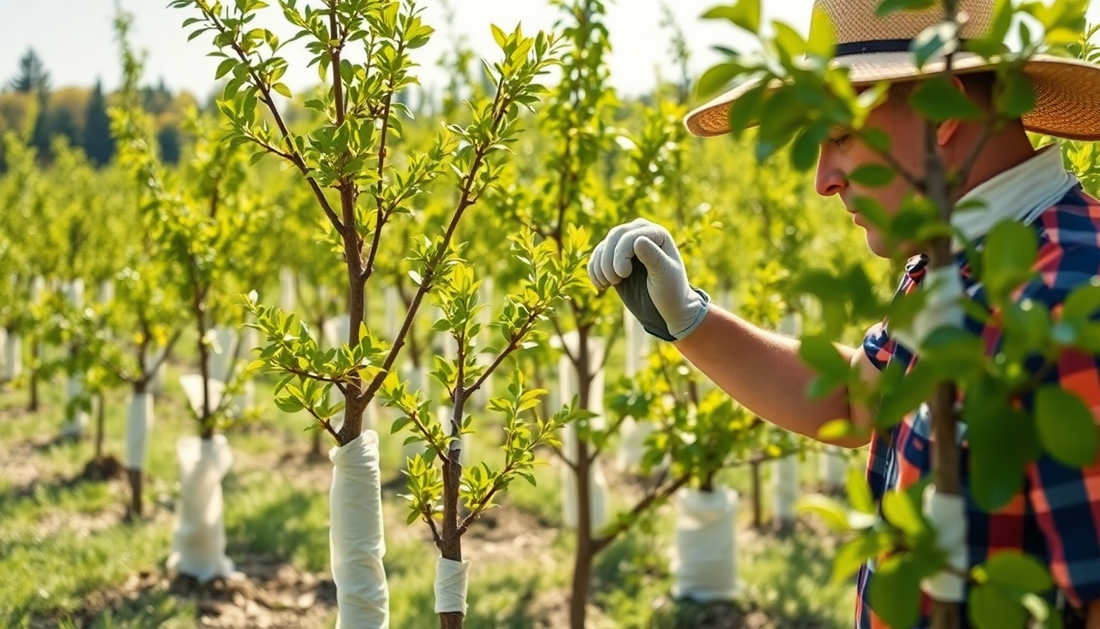
Protecting Your Young Fruit Trees from Sunscald
As the warm spring sun begins to shine brightly, fruit tree owners must be vigilant in protecting their young trees from a common and damaging condition known as sunscald. Sunscald, also referred to as southwest injury, occurs when the bark on the south or southwest side of a tree's trunk is damaged by intense sunlight and fluctuating temperatures.
This blog post will explore the causes of sunscald, its effects on fruit trees, and the most effective methods for preventing this issue and ensuring the long-term health and productivity of your orchard.
Understanding Sunscald
Sunscald is a type of bark injury that occurs when the sun's rays strike the trunk of a young, thin-barked tree, causing the tissue to overheat and die. This typically happens on the south or southwest side of the trunk, as these areas receive the most direct sunlight, especially during the winter months when the sun is lower in the sky.
The damage caused by sunscald can take several forms:
- Cracked or peeled bark: The intense heat causes the bark to dry out and crack, or even peel away from the trunk.
- Sunken, discolored areas: Damaged bark tissue will appear sunken and discolored, often turning brown or black.
- Exposed, vulnerable wood: Once the protective bark layer is compromised, the underlying wood is left exposed and vulnerable to further damage, disease, and pest infestations.
Sunscald is particularly problematic for young, thin-barked fruit trees, such as apple, pear, peach, and plum trees, as their bark is not yet thick and hardy enough to withstand the harsh effects of direct sunlight.
Causes of Sunscald
The primary cause of sunscald is the combination of intense sunlight and rapid temperature fluctuations, which can occur during the winter and early spring months.
During the day, the sun's rays heat up the exposed bark on the south and southwest sides of the tree trunk. As the sun sets and temperatures drop, the bark quickly cools, causing the tissue to contract and crack. This cycle of heating and cooling can eventually lead to the death of the bark and underlying cambium layer.
Other factors that can contribute to sunscald include:
- Young, thin bark: Newly planted or young fruit trees have thinner, more vulnerable bark that is less able to withstand the effects of direct sunlight.
- Sudden exposure: Trees that are suddenly exposed to direct sunlight, such as those that were previously shaded by other trees or structures, are more susceptible to sunscald.
- Extreme weather events: Sudden temperature swings, such as a warm spell followed by a hard freeze, can exacerbate the effects of sunscald.
- Poor soil conditions: Trees growing in poor, compacted, or nutrient-deficient soil are more prone to sunscald, as they are less able to withstand environmental stresses.
Preventing Sunscald
Fortunately, there are several effective methods for preventing sunscald and protecting the trunks of your young fruit trees:
Tree Wraps and Shields
One of the most common and effective ways to prevent sunscald is to use tree wraps or shields. These products are designed to cover the vulnerable bark on the south and southwest sides of the trunk, shielding it from direct sunlight and preventing the rapid temperature fluctuations that lead to cracking and peeling.
When selecting a tree wrap or shield, look for products made from materials such as:
- Corrugated cardboard: Inexpensive and easy to install, cardboard wraps provide a basic level of protection.
- Plastic or burlap: More durable than cardboard, these wraps can be reused for multiple seasons.
- Reflective materials: Wraps made from reflective materials, such as aluminum, can help deflect the sun's rays and further reduce heat buildup.
Be sure to install the wraps or shields in the fall, before the first signs of cold weather, and remove them in the spring once the risk of sunscald has passed.
Whitewashing or Painting
Another effective method for preventing sunscald is to apply a whitewash or light-colored paint to the exposed trunk of the tree. The light color helps reflect the sun's rays, reducing the amount of heat that the bark absorbs.
To create a whitewash, mix together equal parts of white latex paint and water. Apply the mixture to the trunk, making sure to cover the entire exposed area. Reapply the whitewash annually, as it can wear off over time.
Shading and Mulching
Providing shade and insulation for the trunk can also help prevent sunscald. Consider planting companion plants or erecting a temporary shade structure to block direct sunlight. Additionally, applying a thick layer of organic mulch around the base of the tree can help insulate the soil and trunk, reducing temperature fluctuations.
Proper Pruning and Training
Proper pruning and training techniques can also help mitigate the risk of sunscald. Encourage the development of a strong, well-branched tree structure that shades the trunk, and avoid excessive pruning that can leave the trunk exposed.
Monitoring and Addressing Sunscald
Even with preventative measures in place, it's important to regularly monitor your fruit trees for signs of sunscald. Inspect the trunks for any cracked, peeled, or discolored bark, and address any issues promptly.
If you do discover sunscald damage, there are a few steps you can take to help the tree recover:
- Remove damaged bark: Carefully remove any loose or peeling bark, taking care not to damage the underlying cambium layer.
- Apply a tree wound dressing: Apply a tree wound dressing or pruning sealant to the affected area to protect the exposed wood and prevent further damage.
- Provide additional protection: Consider adding a tree wrap or shield to the affected area to prevent future sunscald.
By understanding the causes of sunscald and implementing effective prevention strategies, you can help ensure the long-term health and productivity of your fruit trees. With a little care and attention, you can enjoy bountiful harvests for years to come.






No comments